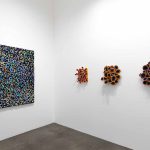Lawrie Shabibi is thrilled to announce the much-anticipated exhibition Tethys by renowned Lebanese American artist Nabil Nahas, in conjunction with the reopening of our gallery space. The exhibition, scheduled to run from 30 October to 5 January, 2024, will take the viewer on a journey through the boundless world of colour, texture, and imagination.
Nabil Nahas, drawing inspiration from his Mediterranean roots —reconnecting to the places of his childhood, Lebanon and Egypt and a deep affinity for the human soul— explores these themes through the lens of colour, texture, and the enigmatic world of nature. He takes cues from celestial and marine phenomena, creating multi-layered paintings that evoke a sense of biomorphic and organic forms. Nahas’s artistic expression is rooted in abstract geometry and three-dimensional explorations, playing with scale to invite visitors to delve into microcosmic worlds within the canvas. Nabil Nahas presents us with a carefully curated selection of his latest paintings that transport us into a realm bursting with vibrant hues, tactile experiences, and hypnotic atmospheres. His artwork features vivid depictions of cedars, olive trees, palms, alongside his evolving Fractal series.
Within his Landscapes series, Nahas portrays the trees in a way that magnifies their presence. His cedars loom large in the viewer’s gaze, their towering forms dominating the scene. Meanwhile, when it comes to his olive trees and palms, his focus narrows to the rugged and irregular textures of their trunks. The artist employs a spectrum of emotions by alternating between vivid and sombre hues throughout different stages of this series. Gold paint adds a reflective quality to his canvas, symbolising the brightness of happy memories. In contrast, the use of black involves bold, gestural strokes that convey a sense of weight or depth, symbolising the gravity of dark memories. The artist’s skill in combining colours and shapes evokes strong feelings related to the 4 August 2020 Beirut explosion. Four of his eight largest pieces explore visceral emotions including grief, shock, resilience, hope, and even anger connected to this tragic event and can be a healing and cathartic process for the artist.
One of the distinctive techniques used by Nahas in his Fractal paintings involves the ‘encrusted’ technique, where he constructs a three-dimensional surface by layering textures and materials. The artist builds up layers of paint and materials, allowing some to protrude while others recede. This mimics the geological formations and organic growth found in the sea floor or the craters of the underwater world. He often uses blues and greens to evoke the colours of the ocean, but he also incorporates earthy tones and metallic accents to simulate the shimmering and the reflective nature of water.
‘Tethys’ refers to the rich history of the Tethys Sea —an enigmatic body of water that once stretched across what is now the Mediterranean region, Middle East, and parts of Asia. This ancient sea played a pivotal role in shaping the geological and biological evolution of our planet. In Greek mythology, Tethys, born of Uranus and Gaia, was both the sister and spouse of the Titan Oceanus and played the role of the mother to the river gods and the Oceanids.
Press release from Lawrie Shabibi



